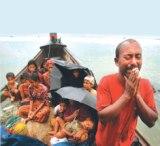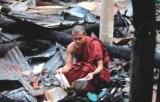The Purge
The systematic elimination of Hindus in Bangladesh
 The issue of the age old perse cution of Hindus in Pakistan ever since its inception ranging from loot and arson of their houses, desecration of temples and shrines, forcible seizure of their business premises, kidnapping and ravaging of women has reached a stage where their lives have become totally insecure. So far, 480 Hindu families who came on visas from their native land of Pakistan for the holy Kumbha Mela have sought political asylum in India. Their statements before the media reveal the well-designed move of Islamic fundamentalists to drive them out. The population of Hindus which stood at 22% in 1951 has been drastically reduced to 2% in the country today.
The issue of the age old perse cution of Hindus in Pakistan ever since its inception ranging from loot and arson of their houses, desecration of temples and shrines, forcible seizure of their business premises, kidnapping and ravaging of women has reached a stage where their lives have become totally insecure. So far, 480 Hindu families who came on visas from their native land of Pakistan for the holy Kumbha Mela have sought political asylum in India. Their statements before the media reveal the well-designed move of Islamic fundamentalists to drive them out. The population of Hindus which stood at 22% in 1951 has been drastically reduced to 2% in the country today.
The tale of Hindus is similar to that of the Buddhists and Christians in Bangladesh. In the aftermath of the more than three months of violence which started at the beginning of the year against Hindus triggered by the nationwide demand for death punishment to the war criminals of 1971, questions have been raised by Amnesty International and human rights activists and organizations about the fate of the minorities in Bangladesh. Strangely enough, as in the past, Hindus have been again made scapegoats in the ongoing war of attrition between the diametrically opposite forces. Quite ominous is the involvement of Jamaat-e-Islam and its student wing Chhatra Shibir backed by the Bangladesh Nationalist Party (BNP) of Khaleda Zia.
 The genesis of the crisis and conflict lies in the pronouncement of the International War Tribunal awarding death sentences to Jamaat leaders who included its President, Dilwar Hossain Sayedee, Acting Secretary, Maulana Rafiqul Islam Khan, and Assistant General Secretary, Muhammad Quamuruzzaman for their crimes against humanity during the Bangladesh Liberation War of 1971. In all, 195 persons including 7 Jamaat leaders have been identified for collaborating with the Pakistani army and ‘Razakars’ which was the paramilitary force organized by the Pakistan Army in East Pakistan during the Bangladesh Liberation War in 1971. All of them are facing trials before the Tribunal for the mass murder of civilians, burning and looting of their properties, ravaging women and letting loose a reign of terror to frustrate the freedom war. The 3 judge Bench International War Tribunal headed by Obidul Hassan is yet to pronounce a death sentence to four other Jamaat leaders.
The genesis of the crisis and conflict lies in the pronouncement of the International War Tribunal awarding death sentences to Jamaat leaders who included its President, Dilwar Hossain Sayedee, Acting Secretary, Maulana Rafiqul Islam Khan, and Assistant General Secretary, Muhammad Quamuruzzaman for their crimes against humanity during the Bangladesh Liberation War of 1971. In all, 195 persons including 7 Jamaat leaders have been identified for collaborating with the Pakistani army and ‘Razakars’ which was the paramilitary force organized by the Pakistan Army in East Pakistan during the Bangladesh Liberation War in 1971. All of them are facing trials before the Tribunal for the mass murder of civilians, burning and looting of their properties, ravaging women and letting loose a reign of terror to frustrate the freedom war. The 3 judge Bench International War Tribunal headed by Obidul Hassan is yet to pronounce a death sentence to four other Jamaat leaders.
Millions of people have been on the streets across the nation, pressing for death sentences to the Jamaat leaders in particular. The Shahbag in Dhaka has become the focal point of a mass movement in this regard. The radical Islamists are equally determined to oppose the execution of the Jamaat leaders. As the bloggers using the high tech media channel have also become vociferous in condemning extreme Islamists, another diehard fundamentalist outfit, Hefat-e-Islam, has emerged in the volatile situation, demanding passage of an anti blasphemy act along with 12 other demands. This has been widely seen as nothing short of an attempt to confound the situation and reinforce their clamour for Sharia in the country.
| The population of Hindus which stood at 22% in 1951 has been drastically reduced to 2% only |
In the midst of the continuing mayhem, Hindus despite being peace-loving citizens of the country continue to reel under fear and shock. According to the influential ‘Daily Star’ of Dhaka, till date 1500 Hindu households have been set on fire, more than a thousand temples defiled besides uncounted business places vandalized. The worldwide condemnation on attacks on Hindus might have halted the mayhem but many intriguing questions have cropped up about the future of Hindus in Bangladesh. If they can’t be safe under Sheikh Hasina’s Awami League Government, what will happen to them if the BNP of Khaleda returns to power in 2014?
The pertinent question that arises here is - Why are the Hindus being targetted? All the forces cutting across political allegiance join the fray to create fear-psychosis among the Hindus, force them to desert their hearths and homes and then grab them. This is no myth but a reality. A research study carried out by Professor Abdul Barkat of Dhaka University has shown that the land and property grabbers belong to all major political parties – Awami League, Bangladesh Nationalist Party, Jamaat-e-Islam and Jatiya Party. In the process, around 2 lakh Hindu families have been disposed of 40,000 acres of land and about 40,000 houses between 1998 and 2004 alone. Hindus, the well documented paper, reveal have been the worst affected in the well-orchestrated violence and repression perpetrated on them during the five year rule of BNP (2001-2006).
| If they can’t be safe under Sheikh Hasina’s Awami League Government, what will happen to them if the BNP of Khaleda returns to power in 2014? |
The study of Professor Barkat further reveals that 45 percent of land grabbers belonged to BNP, 31 percent to Awami League, 8 percent to Jammat-e-Islam and 6 percent to Jatiya Party and others. The land and property grabbers were led by politically influential persons. The research paper titled ‘Deprivation of Affected Families: Living with Vested Property in Bangladesh’ brings to the fore more alarming facts. It states that during the five year rule of Begum Khaleda Zia, the Hindus lost 2.2 million acres of land valued at $ 4.2 billion which is more than half of the country’s GDP (Gross Domestic Product). About 1.2 million or 4 percent of the 2,70.000 Hindu households in the country were affected by the Enemy Property Act of 1965, now called Vested Property Act of 1974.
 The Vested Property Act was enacted by the Sheikh Hasina Government in order to restore the land of the Hindus. The study says no record was prepared to enact the law. The media has criticized the move as a ‘political gimmick’ to woo the Hindus and keep them in good humour. The research paper has found many loopholes in the law which failed to work on the ground as no list of people evicted from their land has been prepared. In fact, enough leeway exists for the land grabbers. Bangladesh National Institute of population Research and Training, an organization working for the protection of the rights of minorities, has attributed socio-economic-political discrimination, repression, extortion, land and property grabbing as well as insecurity of women folk to the systematic and gradual exodus of the Hindus to India.
The Vested Property Act was enacted by the Sheikh Hasina Government in order to restore the land of the Hindus. The study says no record was prepared to enact the law. The media has criticized the move as a ‘political gimmick’ to woo the Hindus and keep them in good humour. The research paper has found many loopholes in the law which failed to work on the ground as no list of people evicted from their land has been prepared. In fact, enough leeway exists for the land grabbers. Bangladesh National Institute of population Research and Training, an organization working for the protection of the rights of minorities, has attributed socio-economic-political discrimination, repression, extortion, land and property grabbing as well as insecurity of women folk to the systematic and gradual exodus of the Hindus to India.
This has been clearly reflected in the 2011 Census Report of Bangladesh. The population of Hindus in all the districts of the country has been showing a declining trend. In 1901, the total population of Hindus was 33% which has come down to 8.5% in 2011 as recorded by the Statistical Year Book of the country. Quite interestingly, Bangladesh Bureau of Statistics officials are describing the ever decreasing number of Hindus as a ‘missing population’. The Human Rights Commission of Bangladesh has expressed the apprehension that in another 50 years Hindus will be totally decimated in the country.


